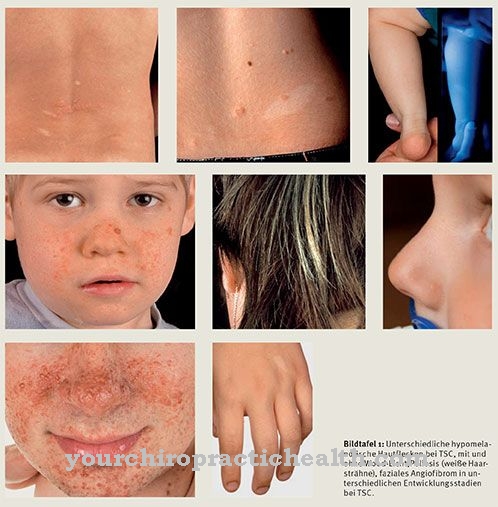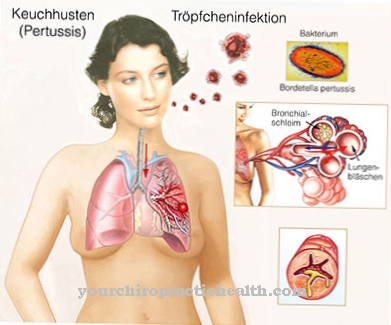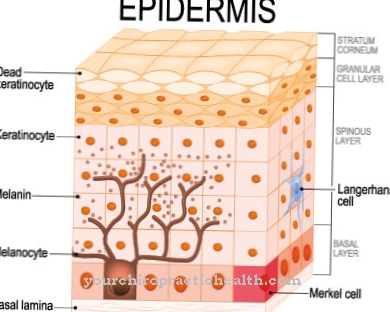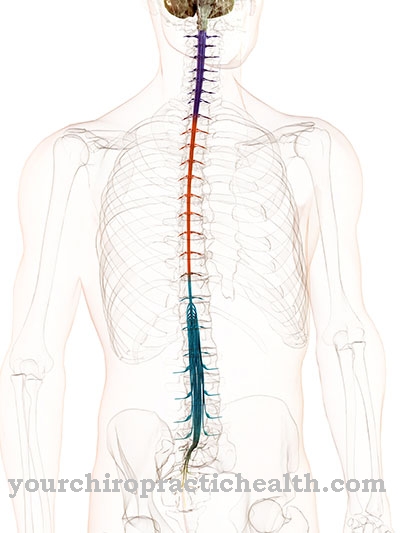As intrauterine growth retardation is called a prenatal developmental disorder. Synonyms for intrauterine growth retardation are prenatal dystrophy and fetal hypertrophy.
What is intrauterine growth retardation?

© serhiibobyk - stock.adobe.com
In the intrauterine growth retardation there is a pathological delay in the growth of an unborn child in the womb (uterus). The affected children are referred to as SGA children. SGA stands for "small for gestational age". Intrauterine growth retardation, also called IUGR for short, occurs when the weight and size of the unborn child are below the 10th percentile.
The causes of an IUGR can be genetic or influenced by environmental factors. The cause can be both with the child and with the mother. Intrauterine growth retardation is usually discovered during prenatal care in the first or second trimester. Around a quarter of all stillbirths are due to intrauterine growth retardation. The growth retardation can lead to metabolic changes in the fetuses, so that the affected children have a higher risk of death.
causes
One fetal cause of IUGR is chromosomal aberration. A chromosomal aberration is a chromosomal abnormality that affects a genome. The most popular aberration is trisomy 21, also known as Down syndrome. Malformations such as agenesies or aplasias can also lead to growth retardation. When viruses are transmitted from mother to child, they can affect the development and growth of the fetus.
It is transmitted through the placenta. Infections of the mother with rubella, toxoplasma or genital herpes pose a particularly high risk of disease for the child. The intrauterine growth retardation can also originate in the placenta. A common cause of growth retardation is multiple pregnancy.
Depending on the space, growth deficits can occur in one or more children. Placental insufficiency also affects the child's growth. Acute placental insufficiency results from acute circulatory disorders. Chronic placental insufficiency is triggered by chronic illnesses in the expectant mother.
If high blood pressure and proteinuria occur during pregnancy, preeclampsia is usually present. A fetal complication of preeclampsia is intrauterine growth retardation. Maternal causes of growth retardation are autoimmune diseases and kidney diseases. Gestational diabetes in the mother can also have a negative impact on the growth of the unborn child.
The fetus will also grow with a delay if it receives too little oxygen. Such hypoxia can be caused by anemia, cardiovascular disease, or lung disease. High blood pressure, alcohol abuse and smoking during pregnancy also damage the unborn child and lead to delayed growth. Due to the risk of intrauterine growth retardation, some drugs are contraindicated during pregnancy.
Symptoms, ailments & signs
The IUGR can be divided into two forms. The asymmetrical shape occurs 70 percent of the time. Initially only body weight is affected by the developmental disorder. The height is normal, but the waist circumference is reduced. The children have too little subcutaneous fatty tissue and as a result develop a very small and thin body, the proportion of which does not match the head.
In the symmetrical form of intrauterine growth retardation, the weight and length of the unborn child are reduced. The head circumference is in the correct proportion to the rest of the body, but overall body growth does not correspond to the normal values. The intrauterine growth retardation can lead to drastic changes in the child's metabolism.
These metabolic disorders can worsen and worsen after birth, increasing the risk of certain chronic diseases later in life. Coronary heart disease (CHD) is one of these diseases. This phenomenon is also known as fetal programming.
Suboptimal conditions during pregnancy lead to an irreversible susceptibility to disease in the unborn child. The intrauterine growth retardation results in structural changes in organs, a changed number of cells, a changed blood supply and a changed number of cell receptors. The children can initially compensate for these changes well, but in the course of life they develop diseases more often than children who have not been affected by IUGR.
Diagnosis & course of disease
The intrauterine growth retardation is usually detected during prenatal care in the second or third trimester during the ultrasound examination. A so-called fetometry is carried out with the aid of ultrasound. The unborn child is measured in the womb. Routine parameters include the head circumference, biparietal diameter, the circumference of the fetal abdomen, and the length of the femur.
If there are any abnormalities, further examinations are carried out. These examinations include Doppler sonography and fetal blood gas analysis. The fetal blood gas analysis checks the oxygen levels in the child's blood vessels. Cardiotography is used to record and monitor fetal heart activity. An amniocentesis may be performed. Here, amniotic fluid is removed from the embryonic blastocyst by puncturing the amniotic sac.
Genetic diseases of the embryo can be clarified through special examinations of the amniotic fluid. If the mother is suspected of having an infection, a TORCH serology is performed. The TORCH complex describes various infectious diseases that can spread to the unborn child during pregnancy. In the laboratory, the mother's blood is tested for toxoplasma, coxsackie virus, syphilis, HIV, parvovirus B19, listeriosis, rubella, cytomegaly and herpes simplex viruses.
Complications
In this disease, growth retardation occurs in the womb. As a rule, this disease leads to extreme consequential damage after birth and thus to a significant reduction in life expectancy. Primarily, the patients suffer from a greatly reduced body weight. Likewise, different lengths of the body can be deformed and damage to the internal organs occurs.
Metabolic disorders can also occur due to growth retardation and thus lead to various complications in adulthood.In most cases, the symptoms of this disease cannot be completely combated, which means that life expectancy is reduced and the patient is more susceptible to infections after the birth.
In some cases, the mental development of the patient is also limited or greatly slowed down by this disease. This can also lead to malformations of the heart. After birth, the growth retardation can no longer be treated causally. If the symptoms are recognized before the birth, the expectant mother should avoid drugs and follow a healthy lifestyle.
This can limit further damage. If the growth retardation is caused by another disease, a premature birth may have to be initiated. This can lead to various complications.
When should you go to the doctor?
An expectant mother should generally take part in all preventive and check-up examinations offered during pregnancy. With these examinations, delays in the development of the embryo several months before the calculated due date can be detected and diagnosed by the doctor using imaging methods.
If the expectant mother has the vague feeling that something may be wrong with the fetus or the general development during pregnancy, she should consult a doctor. If the pregnancy belly grows unusually little or if the weight gain of the pregnant woman is very small, these abnormalities should be discussed with a doctor. If the expectant mother determines a peculiarity of the metabolism, the consultation of a doctor is necessary. A doctor should be consulted in the event of disturbances in the heart rhythm, changes in blood pressure or rapid heartbeat. If sleep disturbances arise, fears or uncertainties arise, it is advisable to consult a doctor. If there are genetic diseases in the family, these should be discussed with a doctor and clarified in a targeted manner.
Therapy & Treatment
Therapy depends on the cause. Alcohol and nicotine consumption must be stopped immediately. One goal of therapy is to improve placental blood flow. Pregnant women often have to stay in bed after diagnosis. Inpatient admission may be required. In severe cases, childbirth is initiated before the 37th week of pregnancy.
Outlook & forecast
The intrauterine growth retardation has no consequences for the health of the mother, but it has serious effects on the health of the unborn child. First of all, changes occur in the metabolism of the fetus, which ensure that physical functions cannot develop in accordance with their age. As a result, the child can be born with physical and mental developmental disorders. At best, the baby is underweight at birth and its development can be encouraged through appropriate nutrition after birth so that it no longer suffers from intrauterine growth retardation in later life.
In the worst case, the consequences result in an increased risk of certain chronic diseases that only appear in the course of life. For example, the risk of affected children of later developing coronary heart disease is increased by intrauterine growth retardation.
If the problem is caused by an underlying disease of the fetus, the prognosis for the further life of the baby depends heavily on this underlying disease. Because it is likely to be born underweight and very small, it has hardly any energy reserves to cope well with the stresses of its underlying disease. Affected babies have to be looked after and examined by a doctor early after birth, because this is the only way to identify physical and psychological damage at an early stage and to contain its consequences for health in good time.
Aftercare
Intrauterine growth retardation requires intensive medical care during and after pregnancy. Physical damage to the infant can be contained through immediate treatment and the subsequent follow-up care. This is very important for the child's health. For the women affected, it is important to strictly follow the doctor's recommendations after the diagnosis.
The focus here is on consistent bed rest. The expectant mother needs a lot of sleep and rest. This protection has a positive effect on the course of the disease and affects both the mother and the unborn child. The stress level should be reduced as much as possible. At the same time, physical exertion is a taboo for the women concerned.
Depending on the situation, only short walks are allowed. The fresh air and light movement stabilize the physical condition and also improve the mood. This has a positive effect on the psyche and the overall condition. Diet also plays a role.
Together with the doctor, the patient should adjust the meal plan in order to supply the body with sufficient nutrients. With balanced meals, lots of vegetables and fresh fruit, the organism gets the necessary strength. Too few calories, on the other hand, can have a detrimental effect on the further course of pregnancy.
You can do that yourself
In everyday life there are some methods that those affected can use to help themselves. The most important thing to note is that bed rest should be observed. This specifically affects cases where it has been prescribed by the doctor. As part of bed rest, attention should be paid to the quality and quantity of sleep. Sufficient sleep is essential to protect the sick and the unborn, even without prescribed bed rest.
General lifestyle also plays a role. If there is a possible stress level, this should be reduced to a minimum if possible. In this way, the greatest possible protection for the sick can be achieved. Those affected should keep any exertion as low as possible and avoid vigorous physical activity. However, this does not apply to short walks in the fresh air. These can have a positive effect on the psyche and body and thus contribute to an improvement in the condition.
Furthermore, the diet of the sick has to be controlled. If this is too one-sided, the diet should be changed. A suitable menu contains the best possible balanced diet, lots of fresh fruit and vegetables. Insufficient calorie intake can also be harmful. It is therefore important to ensure that there is sufficient nutrient intake. Any nicotine or alcohol consumption should be stopped immediately after diagnosis.


.jpg)
.jpg)























